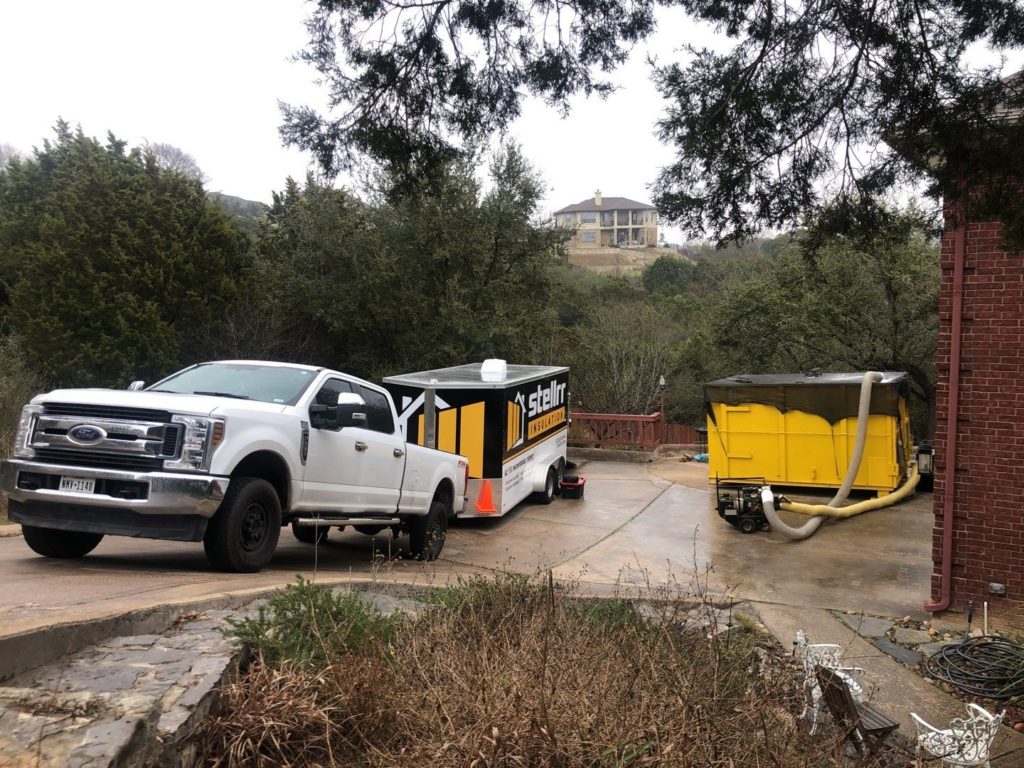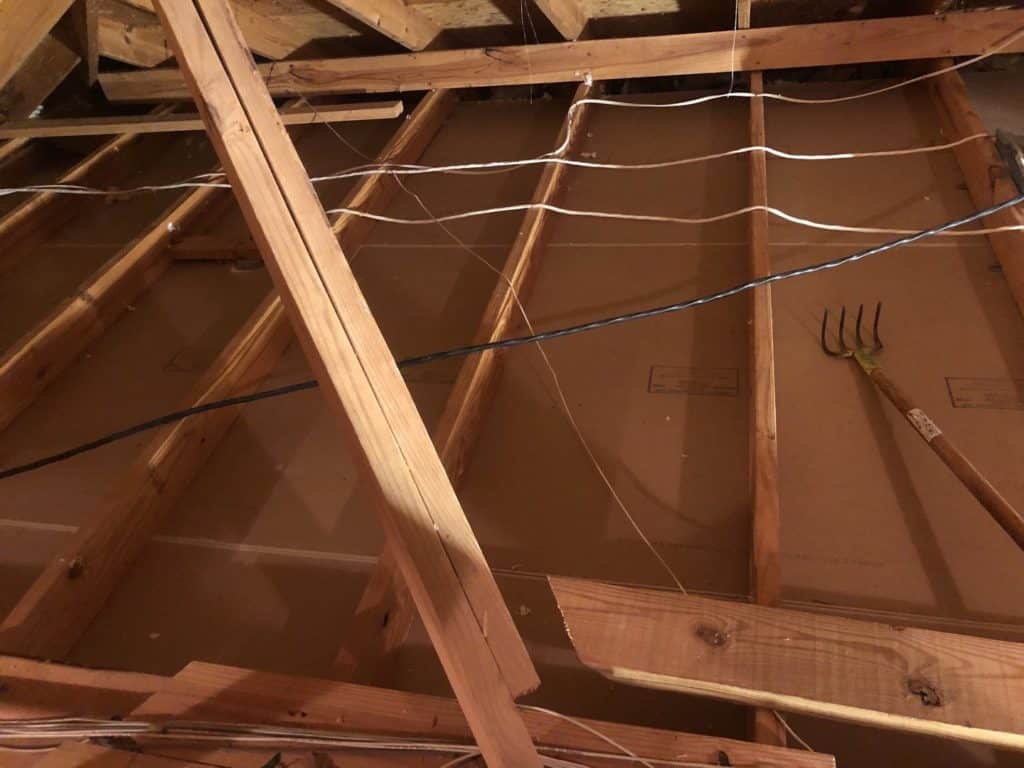Why insulation removal is critical to fixing it right?
How does Stellrr remove insulation?
Imagine a Dyson Vacuum with a Jet Engine attached. We have a removal rig built exclusively for insulation removal. Inside the rig is our 23-horse power vacuum and a couple hundred feet of 4″-6″ hose. The vacuum stays outside.
Inside the house, we first install protection for your floor, walls, window seal. The places where we have to walk and where the hose has to be run. Then, we bring some of the hose into the house to the attic access point. Our crew suits up to suck out the loose blown insulation, feces, and all the nastiness.

If we are removing batt (sheets) of insulation, we stuff those into bags, and carry them outside using the most minimally invasive route.
Often we rent one of our Dumposaurus dumpsters out to put all the insulation in. Check out the video on Dumposaurus delivery. We use DinoTraks to protect your driveway so the bin never touches the ground.
How messy is the removal?
Imagine running that little hose extension on your home vacuum cleaner. This is kinda like a supersized version. Removal is a clean up project and thus very clean. All dust from the removal is kept outside by the dumpster. Shawn built a custom lid for the dumpster so that it is the absolute cleanest solution available anywhere.

What is INCLUDED in the proposed removal?
In general, our quotes include up to 10 inches of loose blown insulation thickness or exposed access batts not enclosed by drywall, wiring, or similar. Insulation may be infested with allergens, rodent droppings, and other items that CAN be processed by the vacuum without damaging our equipment.
If the insulation work to be done is over/under the conditioned space of the house, then that specified area is to be removed. If a garage or porch needs removal, it is only included IF specified by a separate removal line item.
Blown attic insulation removal jobs priced at least $2,500 includes:
- 1 dumpster per 1,500 sq ft.
- Emptying the “Dead Man Box” 2 times
- 3 contractor bags of debris hand pulled from attic
- Up to 3 Stellrr removal crew members for a day of work
What is EXCLUDED in the proposed removal?
In most cases, removals happen without any problems. But here are the hazards that can impact the estimated price.
AREA TO BE REMOVED: unless specified by a separate line item, garages and porches are not cleaned. The proposals are built based on the Central Appraisal District (CAD) measurements of the house plus any in field measurements. Just as the CAD separates garages and porches into separate line items, we do too if we are working on them.
ENCLOSURES: If the insulation is enclosed behind drywall/chicken wire, to where we have to remove drywall/chicken wire in order to access and remove the insulation. That is not included unless specified as “Remove Drywall Covered Insulation” or “Remove Chicken Wire Enclosed Insulation”
LAYERS OF INSULATION: Multiple layers of insulation (ex: pink/gray) is no big deal. What is an issue is when a nice fresh layer of insulation is installed on top of severely compacted insulation, or debris infested insulation.
EXCESSIVE DEBRIS: We expect every attic to have some debris in it. As mentioned in the “include” section, we account for what is typical. What we cannot know until we are doing the work is how much debris. The most common issue is when roofers redo a house and drop shingles, nails, and other hazards in the attic.
The problem is that we cannot sort the hazards out before it too is late:
- clog the hose (shutting down all work),
- puncture the hose (decreasing efficiency),
- it goes down the hose to the Dead Man box,
- bypasses Dead Man box, shoots out the vac exhaust and hurts someone.
Per 1,500 sq ft of removal, jobs requiring more than the “included” will have the following added to the final invoice:
- $497 per each additional dumpster
- $73 per additional Dead Man box emptying
- $9 per additional filled contractor bag
- $475 per added day to help cover removal crew wages
$149 per added day for use of vacuum equipment
How likely am I to have the issues above that change the estimated price?
It is rare. Most homes we work in are straightforward. Plus if your house footprint is more than 1,500 sq ft, then you get additional stuff included. We do removals every week, and I believe we have only added to one clients invoice. His roofers basically dumped most of the shingles in his insulation. Then they blew in a layer of insulation on top hiding it.
Can we stay in the house while the insulation is being removed?
Yes, while insulation is being removed you can stay in the house without any concern. You may hear some noise in the attic or crawlspace as the crew crawls around (kinda like a large mouse noise hehe). The engine on the vacuum is outside, away from the house. It sounds similar to the lawnmower running, except it is a constant hum. So the removals are pretty easy to stay in the home during.
Why is insulation removal is essential?
Hot air in our attics expand and pushes itself down into our air conditioned homes through cracks and penetrations. While hot air leaks in, it pushes out the air you paid to cool. This hot air is full of allergens and is pushed into your breathing air. The conditioned air is pushed out through the crawlspace under the house, or through cracks and penetrations at the bottom of the house.
To stop this cycle, we must air seal the home. To properly air seal a home, all the insulation must be removed from the attic.
There are 4 big reasons for removal:
1. We remove the old insulation so we can seal the house. Air sealing allows us to keep the conditioned air from leaking out, manage the moisture, kill off dust mites, fungal, mold & viruses that grow in high humidity. Air sealing requires a proper seal on the top plates & drywall, you have to be able to see where you need to seal. You can’t see everything when it is covered in a blanket of insulation.
2. The surface needs to be clean for adhesion. Otherwise it is like laying caulk on the beach. Then pulling it up. It’ won’t stick.
3. By putting insulation on top of existing insulation you are trapping in all the allergens and feces that used to float out of your vented attic. The intensity of which those pollutants come into your indoor air will multiply.
What is in your existing insulation that may be making you sick?
- Remove discontinued insulation with asbestos or formaldehyde
- Expose to remediate water damage and fungal from past roof leaks
- Remove the pee and poop from rodents
- Suck out years of allergens stored in the insulation
- Suck out nests and breeding grounds for insects
Until your house is air sealed and old insulation removed, you will be breathing all that nasty air.
4. If the roof gets spray foamed, we are moving the thermal boundary from your attic floor to your attic ceiling (the under side of your roof decking). If the floor insulation is left in, then you have two thermal boundaries. Which will hold more moisture, leading to mold, and wood rot. These reasons are why we usually won’t insulate a house without removing the existing insulation in the space where we are working.
We highly recommend having the attic sterilized and sanitized after removal to kill off and fully eliminate micro-organisms on the bacterial and fungal level.

Here is what to do next.
Approve the Project and the Pay Deposit. Or request a change to the estimate your received from your Solutions Specialist.
Don’t make the mistake I did. Let’s create a safe and healthy indoor environment for you and your family.
Changing Lives, Cleansing Homes. Stellrr
